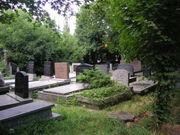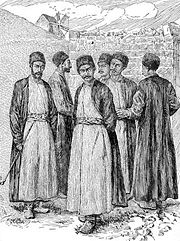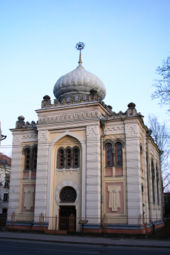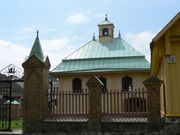Crimean Karaites
2008/9 Schools Wikipedia Selection. Related subjects: Peoples
The Crimean Karaites (Crimean Karaim: sg. къарай - qaray, pl. къарайлар - qaraylar; Trakai Karaim: sg. karaj, pl. karajlar, Hebrew קָרָאִים - qara'im, 'readers'), also known as Karaims and Qarays, are a community of ethnic Turkic adherents of Karaite Judaism in Eastern Europe. "Qaray" is a Romanized spelling of the original name "къарай", while "Karaim" is a Russian, Ukrainian, Lithuanian and Polish name for the community. Originally centered in Crimea, Karaims were established in Lithuania and elsewhere in Europe from late medieval times.
The name "Crimean Karaites" is something of a misnomer, as many branches of this community found their way to locations throughout Europe and the Middle East. Nevertheless this name is used for the Turkic Karaite community which originated in Crimea to distinguish it from historically Aramaic, Hebrew, and Arabic-speaking Karaites of the Levant, Anatolia, and the Middle East (i.e. to show the difference between the ethnic group and the religious denomination). For the purposes of this article, the terms "Crimean Karaites", "Karaims", and "Qarays" are used interchangeably, while "Karaites" alone refers to the general Karaite branch of Judaism.
Language
Karaim is a Kypchak Turkic tongue being closely related to Crimean Tatar, Armeno-Kipchak etc. Among many different influences exerted on Karaim Arabic, Hebrew and Persian were the first to change the outlook of the Karaim lexicon. Later due to considerable Polish, Russian and Ukrainian influence a plenty of Slavic words entered the language of Polish, Lithuanian, Ukrainian and Russian Karaims. Hebrew remained in use for liturgical purposes. Following the Ottoman occupation of Crimea, Turkish was used for business and government purposes among Karaims living on the Crimean peninsula. Three different dialects are in use presently: the so-called Troki dialect, used in Trakai and Vilnius (Lithuania), the so-called Lutsk or Halych dialect spoken in Lutsk (until World War II) and Halych, and the Crimean dialect. The last forms the Eastern group, while Troki and Halych Karaim belong to the Western group.
Origins and ethnic identity
Turkic speaking Karaites (in the Crimean Tatar language, Qaraylar) have lived in Crimea for centuries. Their origin is a matter of great controversy. Some regard them as descendants of Karaite Jews who settled in Crimea and adopted a form of the Kypchak tongue (see Karaim language). Others view them as descendants of Khazar (unlikely) or Kipchak (more likely) converts to Karaite Judaism. Today Crimean Karaites deny their Israelite origins and consider themselves to be descendants of the Khazars. Virtually all scholars of Khazar history, however, agree that the Judaism of the Khazars was Rabbinical in nature. Modern Karaims seek to distance themselves from being identified as Jews, emphasizing what they view as their Turkic heritage and claiming that they are Turkic practitioners of a "Mosaic religion" separate and distinct from Judaism. On the other hand, many scholars state that the phenomenon of claiming a distinct identity apart from the Jewish people appears to be no older than the nineteenth century, when it appeared under the influence of such leaders as Avraham Firkovich and Sima Babovich as a means of escaping anti-Semitism.
Whatever their origin, from the time of the Golden Horde onward, they were present in many towns and villages throughout Crimea and around the Black Sea. During the period of the Crimean Khanate some of the major communities could be found in the towns of Çufut Qale, Sudak, Kefe and Bakhchisaray.
Many Karaims were farmers. Members of the community served in the military forces of the Crimean Khanate and of Lithuania.
At the time of this writing (March 2005), genetic testing is being conducted to ascertain their ethnic origin.
Lithuania
In 1392 Grand Duke Vytautas of Grand Duchy of Lithuania relocated one branch the Crimean Karaites to Lithuania where they continued to speak their own language. The Lithuanian Karaites settled primarily in Vilna ( Vilnius) and Troki ( Trakai), but also in smaller settlements throughout Lithuania proper and lands of modern Belarus and Ukraine, that were part of the Grand Duchy of Lithuania. The Karaims in Lithuanian territory were granted a measure of autonomy.
Some famous Karaim scholars in Lithuania included Isaac b. Abraham of Troki (1543 - 1598), Joseph ben Mordecai Malinovski, Zera ben Nathan of Trakai, Salomon ben Aharon of Trakai, Ezra ben Nissan (died in 1666) and Josiah ben Judah (died after 1658). Some of the Karaims became quite wealthy.
During the times of the Polish-Lithuanian Commonwealth, the Karaims suffered severely during the Chmielnicki Uprising of 1648 and the wars between Russia and Poland in the years 1654-1667, when many towns were plundered and burnt, including Trakai, where in 1680 only 30 families were left. Catholic missionaries made serious attempts to convert the local Karaims into Christianity, but ultimately were largely unsuccessful. The local Karaim communities still exist in Lithuania (where they live mostly in Panevėžys and Trakai regions) and Poland. The 1979 census in the USSR showed 3,300 Karaims. Lithuanian Karaims Culture Community was founded in 1988.
According to Lithanian Karaims website the Statistics Department of Lithuania carried out an ethno-statistic research "Karaims in Lithuania" in 1997. It was decided to question all adult Karaims and mixed families, where one of the members is a Karaim. During the survey, i.e beginning 1997 there were 257 Karaim nationality people, 32 of which were children under 16.
Russian Empire
Nineteenth-century leaders of the Karaims, such as Sima Babovich and Avraham Firkovich, were driving forces behind a concerted effort to de-Judaize the Karaite community in eyes of the Russian legal system. Firkovich in particular was adamant in his attempts to connect the Karaims with the Khazars, and has been accused of forging documents and inscriptions to back up his claims.
Ultimately, the Tsarist government officially recognized the Karaims as being of Turkic, not Jewish, origin, a political ruling that has little basis in historical fact. Because the Karaims were judged to be innocent of the death of Jesus, they were exempt from many of the harsh restrictions placed on other Jews. They were, in essence, placed on equal legal footing with Crimean Tatars. The related Krymchak community, which was of similar ethnolinguistic background but which practiced rabbinical Judaism, continued to suffer under Tsarist anti-Jewish laws.
Since the incorporation of Crimea into the Russian Empire the main centre of the Qarays is the city of Eupatoria.
During the Holocaust
Their status under Russian imperial rule bore beneficial fruits for the Karaims decades later. In 1934, the heads of the Karaite community in Berlin asked the Nazi authorities to exempt them from the regulations; on the basis of their legal status in Russia. The Reich Agency for the Investigation of Families determined that from the standpoint of German law, the Karaites were not to be considered Jews. The letter from the Reichsstelle fur Sippenforschung gave the official ruling in a letter which stated:
The Karaite sect should not be considered a Jewish religious community within the meaning of paragraph 2, point 2 of the First Regulation to the Reich Citizenship Law. However, it cannot be established that Karaites in their entirety are of blood-related stock, for the racial categorization of an individual cannot be determined without ... his personal ancestry and racial biological characteristics
–
This ruling set the tone for how the Nazis dealt with the Karaite community in Eastern Europe.
At the same time, the Nazis had serious reservations towards the Karaites. SS Obergruppenfuhrer Gottlob Berger wrote on November 24, 1944:
Their Mosaic religion is unwelcome. However, on grounds of race, language and religious dogma... Discrimination against the Karaites is unacceptable, in consideration of their racial kinsmen [Berger was here referring to the Crimean Tatars]. However, so as not to infringe the unified anti-Jewish orientation of the nations led by Germany, it is suggested that this small group be given the opportunity of a separate existence (for example, as a closed construction or labor battalion)...
Despite their exempt status, confusion led to initial massacres. German soldiers who came across Karaims in Russia during the initial phase of Operation Barbarossa, not aware of their legal status under German law, attacked them; 200 were killed at Babi Yar alone. German allies such as the Vichy Republic began to require the Karaites to register as Jews, but eventually granted them non-Jewish status upon being instructed by Berlin.
On interrogation, Ashkenazi and Krymchak rabbis in Crimea told the Germans that the Karaims were not Jews, in an effort to spare the Karaite community the fate of their Rabbanite neighbors. The record of the Karaite community during the war is a checkered one; while many Karaims risked their lives to hide Jews, and in some cases claimed that Jews were members of their community, others joined German auxiliary units such as the Tatar Legion, Ostturkische Waffenverband, an SS unit that included Crimean Tatars and other Turkic peoples. According to a letter of September 27 1944, penned by Chancellor Gerhard Klopfer, an estimated 500-600 Crimean Karaims were fighting in the Wehrmacht, Waffen SS and Tatar Legion. Klopfer asked that until such a time as the exact racial origin of the Karaites could be determined, a list of all members of the sect be diligently kept. Many of the Karaims were recruited for labor battalions.

In Lutsk the Karaims generally cooperated with the Nazi anti-Jewish activities. In Vilna and Troki Karaite Hakham Seraya Shapshal gave precise lists of the members of their community, allowing the Nazis to quickly discover Jews bearing false Karaite papers. The historian W.P. Green describes the situation in Lutsk thus:
[T]he local Karaites acted as liaisons between the Germans and the Lutsk Judenrat. Jacob Eilbert, a survivor of the Lutsk Ghetto, testified to the Karaite anti-Jewish activity. He recounted that the Karaites would enter the ghetto and beat up women and children. On other occasions they would extort huge sums of money from the Lutsk Judenrat. Eilbert also testified to the fact that the Karaites assisted the Germans and Ukrainians in the liquidation of the Lutsk Ghetto in August 1942. My research, however, indicates that the strained Karaite-Jewish relations described by Eilbert appear to be an exception.
–
Post-War
After the Soviet recapture of Crimea from Nazi forces in 1944, the Soviet authorities counted 6,357 remaining Karaims. Karaims were not subject to mass deportation, unlike the Crimean Tatars, Greeks, Armenians and others the Soviet authorities alleged had collaborated during the Nazi German occupation. Some individual Karaims were deported.
Assimilation and emigration greatly reduced the ranks of the Karaim community. A few thousand Karaims remain in Lithuania, Belarus, Ukraine, Russia, and Poland. Other communities exist in Israel, Turkey, the United States, and Great Britain.


